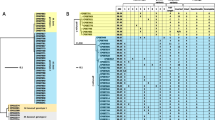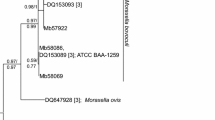Abstract
Moraxella bovoculi has been isolated frequently from cattle with Infectious bovine keratoconjunctivitis (IBK). Two diverse genotypes of M. bovoculi, 1 and 2 were identified based on whole genome sequence analysis. It is essential to discriminate between the two genotypes to frame prevention and control measures. The whole genome of M. bovoculi TN7 was sequenced and compared to other M. bovoculi strains available in the NCBI database. M. bovoculi TN7 was found to be genotype 1, had an RTX toxin operon and pilA gene that are the known virulence factors in related Moraxella sp., but lacked antimicrobial resistance genes. M. bovoculi was found to have an open pangenome with 4051 (75.31%) accessory genes, and the addition of each new genome adds 18 genes to the pangenome. Comparison of pilin protein amino acid sequences revealed three new sequence types. Furthermore, the presence of linx, nagL, swrC and mdtA genes was found to be genotype 1 specific, whereas hyaD, garR, gbsA, yhdG, gabT, iclR, higB2, hmuU, hmuT and hemS were found only in genotype 2. Polymerase Chain Reaction (PCR) primers were designed and evaluated on strain TN7 plus seven additional strains accessible to us that had not been whole genome sequenced. This initial evaluation of the designed primers for the linX and hyaD genes produced the expected banding patterns on PCR gels for genotypes 1 and 2, respectively, among the 8 strains. The genotype-specific genes identified in this study can be used as markers for accurate diagnosis of genotype 1 isolates and this can aid in the development of autogenous or other molecular vaccines for treatment of infectious bovine keratoconjunctivitis (IBK) in resource-limited research settings.





Similar content being viewed by others
Data availability statement
Genome sequence of Moraxella bovoculi TN7 was submitted to NCBI. Corresponding accessions numbers with respect to BioProject, BioSample and SRA are as follows PRJNA792938, SAMN24477548 and SRR17373549.
References
Alcock BP, Raphenya AR, Lau TT, Tsang KK, Bouchard M, Edalatmand A, Huynh W, Nguyen ALV, Cheng AA, Liu S, Min SY (2020) CARD 2020: antibiotic resistome surveillance with the comprehensive antibiotic resistance database. Nucleic Acids Res 48:D517–D525
Angelos JA (2010) Moraxella bovoculi and infectious bovine keratoconjunctivitis: cause or coincidence? Vet Clin North Am Food Anim Pract 26:73–78. https://doi.org/10.1016/j.cvfa.2009.10.002
Angelos JA, Ball LM (2007) Differentiation of Moraxella bovoculi sp. nov. from other coccoid moraxellae by the use of polymerase chain reaction and restriction endonuclease analysis of amplified DNA. J Vet Diagn Invest 19(5):532–534. https://doi.org/10.1177/104063870701900511
Angelos JA, Ball LM, Byrne BA (2011) Minimum inhibitory concentrations of selected antimicrobial agents for Moraxella bovoculi associated with infectious bovine keratoconjunctivitis. J Vet Diagn Invest 23:552–555
Angelos JA, Clothier KA, Agulto RL, Mandzyuk B, Tryland M (2021) Relatedness of type IV pilin PilA amongst geographically diverse Moraxella bovoculi isolated from cattle with infectious bovine keratoconjunctivitis. J Med Microbiol 70(2):001293. https://doi.org/10.1099/jmm.0.001293
Antipov D, Hartwick N, Shen M, Raiko M, Lapidus A, Pevzner PA (2016) plasmidSPAdes: assembling plasmids from whole genome sequencing data. Bioinformatics. https://doi.org/10.1093/bioinformatics/btw493
Aziz RK, Bartels D, Best AA, DeJongh M, Disz T, Edwards RA, Formsma K, Gerdes S, Glass EM, Kubal M, Meyer F, Olsen GJ, Olson R, Osterman AL, Overbeek RA, McNeil LK, Paarmann D, Paczian T, Parrello B, Pusch GD, Reich C, Stevens R, Vassieva O, Vonstein V, Wilke A, Zagnitko O (2008) The RAST Server: rapid annotations using subsystems technology. BMC Genomics 9:1–15
Bankevich A, Nurk S, Antipov D, Gurevich AA, Dvorkin M, Kulikov AS, Lesin VM, Nikolenko SI, Pham S, Prjibelski AD, Pyshkin AV, Sirotkin AV, Vyahhi N, Tesler G, Alekseyev MA, Pevzner PA (2012) SPAdes: a new genome assembly algorithm and its applications to single-cell sequencing. J Comput Biol J Comput Mol Cell Biol 19(5):455–477. https://doi.org/10.1089/cmb.2012.0021
Bertels F, Silander OK, Pachkov M, Rainey PB, Van Nimwegen E (2014) Automated reconstruction of whole-genome phylogenies from short-sequence reads. Mol Biol Evol 31(5):1077–1088
Cantalapiedra CP, Hernández-Plaza A, Letunic I, Bork P, Huerta-Cepas J (2021) eggNOG-mapper v2: functional annotation, orthology assignments, and domain prediction at the metagenomic scale. Mol Biol Evol 38(12):5825–5829
Cock PJ, Chilton JM, Grüning B, Johnson JE, Soranzo N (2015) NCBI BLAST+ integrated into Galaxy. GigaScience 4:39. https://doi.org/10.1186/s13742-015-0080-7
Davis JJ, Wattam AR, Aziz RK, Brettin T, Butler R, Butler RM, Chlenski P, Conrad N, Dickerman A, Dietrich EM, Gabbard JL, Gerdes S, Guard A, Kenyon RW, Machi D, Mao C, Murphy-Olson D, Nguyen M, Nordberg EK, Olsen GJ, Olson RD, Overbeek JC, Overbeek R, Parrello B, Pusch GD, Shukla M, Thomas C, VanOeffelen M, Vonstein V, Warren AS, Xia F, Xie D, Yoo H, Stevens R (2020) The PATRIC bioinformatics resource center: expanding data and analysis capabilities. Nucleic Acids Res 48(D1):D606–D612. https://doi.org/10.1093/nar/gkz943
Dawood WA (2018) Elucidation of the cell surface lipooligosaccharide structure of Moraxella bovoculi and its influence on the growth and biological activity of the microorganism. Master of Medical Research. Griffith University, Gold Coast, Australia. https://doi.org/10.25904/1912/2346
Dickey AM, Loy JD, Bono JL, Smith TP, Apley MD, Lubbers BV, DeDonder KD, Capik SF, Larson RL, White BJ, Blom J, Chitko-McKown CG, Clawson ML (2016) Large genomic differences between Moraxella bovoculi isolates acquired from the eyes of cattle with infectious bovine keratoconjunctivitis versus the deep nasopharynx of asymptomatic cattle. Vet Res 47:31. https://doi.org/10.1186/s13567-016-0316-2
Dickey AM, Schuller G, Loy JD, Clawson ML (2018) Whole genome sequencing of Moraxella bovoculi reveals high genetic diversity and evidence for interspecies recombination at multiple loci. PLoS One 13(12):e0209113
Feldgarden M, Brover V, Gonzalez-Escalona N, Frye JG, Haendiges J, Haft DH, Hoffmann M, Pettengill JB, Prasad AB, Tillman GE, Tyson GH, Klimke W (2021) AMRFinderPlus and the reference gene catalog facilitate examination of the genomic links among antimicrobial resistance, stress response, and virulence. Sci Rep 11(1):12728. https://doi.org/10.1038/s41598-021-91456-0
Gonzales-Siles L, Karlsson R, Schmidt P, Salvà-Serra F, Jaén-Luchoro D, Skovbjerg S, Moore ERB, Gomila M (2020) A pangenome approach for discerning species-unique gene markers for Identifications of Streptococcus pneumoniae and Streptococcus pseudopneumoniae. Front Cell Infect Microbiol 10:222. https://doi.org/10.3389/fcimb.2020.00222
Hille M, Dickey A, Robbins K, Clawson ML, Loy JD (2020) Rapid differentiation of Moraxella bovoculi genotypes 1 and 2 using MALDI-TOF mass spectrometry profiles. J Microbiol Methods 173:105942
Karthik K, Mahaprabhu R, Roy P, Raman M (2018) Emergence of Moraxella bovoculi associated with keratoconjunctivitis in an organized dairy farm of India. Proc Natl Acad Sci India Sect b Biol Sci 88:1409–1412
Letunic I, Bork P (2021) Interactive tree of life (iTOL) v65: an online tool for phylogenetic tree display and annotation. Nucleic Acids Res 49:W293–W296
Liu B, Pop M (2009) ARDB—antibiotic resistance genes database. Nucleic Acids Res 37:D443–D447
Liu H, Yan J, Wang Y, Yan Q, Zhao L, Yan R, He H (2014) Isolation of Moraxella bovoculi from racehorses with keratoconjunctivitis. J Vet Diagn Invest 26(4):585–587. https://doi.org/10.1177/1040638714535601
Loy JD, Brodersen BW (2014) Moraxella spp. isolated from field outbreaks of infectious bovine keratoconjunctivitis: a retrospective study of case submissions from 2010 to 2013. J Vet Diagn Invest 26(6):761–768. https://doi.org/10.1177/1040638714551403
Maboni G, Gressler LT, Espindola JP, Schwab M, Tasca C, Potter L, de Vargas AC (2015) Differences in the antimicrobial susceptibility profiles of Moraxella bovis, M. bovoculi and M. ovis. Braz J Microbiol 46(2):545–549. https://doi.org/10.1590/S1517-838246220140058
Page AJ, Cummins CA, Hunt M, Wong VK, Reuter S, Holden MT, Fookes M, Falush D, Keane JA, Parkhill J (2015) Roary: rapid large-scale prokaryote pan genome analysis. Bioinformatics 31(22):3691–3693. https://doi.org/10.1093/bioinformatics/btv421
Rasko DA, Rosovitz MJ, Myers GS, Mongodin EF, Fricke WF, Gajer P, Crabtree J, Sebaihia M, Thomson NR, Chaudhuri R, Henderson IR, Sperandio V, Ravel J (2008) The pangenome structure of Escherichia coli: comparative genomic analysis of E. coli commensal and pathogenic isolates. J Bacteriol 190:6881–6893
Seemann T (2016) ABRicate: mass screening of contigs for antibiotic resistance genes. https://github.com/tseemann/abricate. Accessed 21 Dec 2021
Tatusova T, DiCuccio M, Badretdin A, Chetvernin V, Nawrocki EP, Zaslavsky L, Lomsadze A, Pruitt KD, Borodovsky M, Ostell J (2016) NCBI prokaryotic genome annotation pipeline. Nucleic Acids Res 44:6614–6624
Tettelin H, Masignani V, Cieslewicz MJ, Donati C, Medini D, Ward NL, Angiuoli SV, Crabtree J, Jones AL, Durkin AS, Deboy RT, Davidsen TM, Mora M, Scarselli M, Margarit Y, Ros I, Peterson JD, Hauser CR, Sundaram JP, Nelson WC, Madupu R, Brinkac LM, Dodson RJ, Rosovitz MJ, Sullivan SA, Daugherty SC, Haft DH, Selengut J, Gwinn ML, Zhou L, Zafar N, Khouri H, Radune D, Dimitrov G, Watkins K, O’Connor KJ, Smith S, Utterback TR, White O, Rubens CE, Grandi G, Madoff LC, Kasper DL, Telford JL, Wessels MR, Rappuoli R, Fraser CM (2005) Genome analysis of multiple pathogenic isolates of Streptococcus agalactiae: implications for the microbial “pan-genome.” Proc Natl Acad Sci USA 102:13950–13955. https://doi.org/10.1073/pnas.0506758102
Trifinopoulos J, Nguyen LT, von Haeseler A, Minh BQ (2016) W-IQ-TREE: a fast online phylogenetic tool for maximum likelihood analysis. Nucleic Acids Res 44:W232–W235
Tryland M, Das Neves CG, Sunde M, Mørk T (2009) Cervid herpesvirus 2, the primary agent in an outbreak of infectious keratoconjunctivitis in semidomesticated reindeer. J Clin Microbiol 47(11):3707–3713. https://doi.org/10.1128/JCM.01198-09
Wick RR, Judd LM, Gorrie CL, Holt KE (2017) Unicycler: resolving bacterial genome assemblies from short and long sequencing reads. PLoS Comput Biol 13:e1005595
Zankari E, Hasman H, Cosentino S, Vestergaard M, Rasmussen S, Lund O, Aarestrup FM, Larsen MV (2012) Identification of acquired antimicrobial resistance genes. J Antimicrob Chemother 67:2640–2644
Zhao Y, Jia X, Yang J, Ling Y, Zhang Z, Yu J, Wu J, Xiao J (2014) PanGP: a tool for quickly analyzing bacterial pan-genome profile. Bioinformatics 30:1297–1299
Zheng W, Porter E, Noll L, Stoy C, Lu N, Wang Y, Liu X, Purvis T, Peddireddi L, Lubbers B, Hanzlicek G, Henningson J, Liu Z, Bai J (2019) A multiplex realtime PCR assay for the detection and differentiation of five bovine pinkeye pathogens. J Microbiol Methods 160:87–92. https://doi.org/10.1016/j.mimet.2019.03.024
Acknowledgements
The authors are thankful to Tamil Nadu Veterinary and Animal Sciences University Chennai, India for providing necessary infrastructure to carry out the research work.
Funding
This research did not receive any specific grant from funding agencies in the public, commercial, or not-for-profit sectors.
Author information
Authors and Affiliations
Contributions
KK: Conceptualized the work and carried out analysis, drafting the manuscript, SA: analysis of pangenome, MAC, PCR for genotyping and RS: overall monitoring of the work and fund acquisition for the work. All authors were involved in drafting and editing of the manuscript.
Corresponding author
Ethics declarations
Conflict of interest
The authors declared that they have no competing interests.
Additional information
Communicated by Erko Stackebrandt.
Publisher's Note
Springer Nature remains neutral with regard to jurisdictional claims in published maps and institutional affiliations.
Supplementary Information
Below is the link to the electronic supplementary material.
203_2022_3276_MOESM1_ESM.jpg
Supplementary Fig. 1 Genome of Moraxella bovoculi TN7. The outer two circles demonstrate the coding sequence, tRNA, and rRNA of M. bovoculi TN7 annotated by Prokka pipeline. The third circle represents the GC skew curve (positive GC skew, green; negative GC skew, violet). The fourth circle shows the GC content (black) (JPG 4954 KB)
203_2022_3276_MOESM2_ESM.jpg
Supplementary Fig. 2 Pangenome curve of M. bovoculi. A. Gene accumulation curves of the pangenome (blue) and core genome (green) of M. bovoculi. B. Number of new genes added with addition of each new M. bovoculi genome (JPG 2114 KB)
203_2022_3276_MOESM3_ESM.jpg
Supplementary Fig. 3 Core genome phylogeny of M. bovoculi strains. Genotype 1 are marked in green color and genotype 2 in yellow color. Red color star marks on the phylogeny indicates 100% bootstrap value (JPG 3280 KB)
Rights and permissions
Springer Nature or its licensor holds exclusive rights to this article under a publishing agreement with the author(s) or other rightsholder(s); author self-archiving of the accepted manuscript version of this article is solely governed by the terms of such publishing agreement and applicable law.
About this article
Cite this article
Karthik, K., Anbazhagan, S., Chitra, M.A. et al. First report of the whole genome of Moraxella bovoculi genotype 1 from India and comparative genomics of Moraxella bovoculi to identify genotype-specific markers. Arch Microbiol 204, 663 (2022). https://doi.org/10.1007/s00203-022-03276-z
Received:
Revised:
Accepted:
Published:
DOI: https://doi.org/10.1007/s00203-022-03276-z




